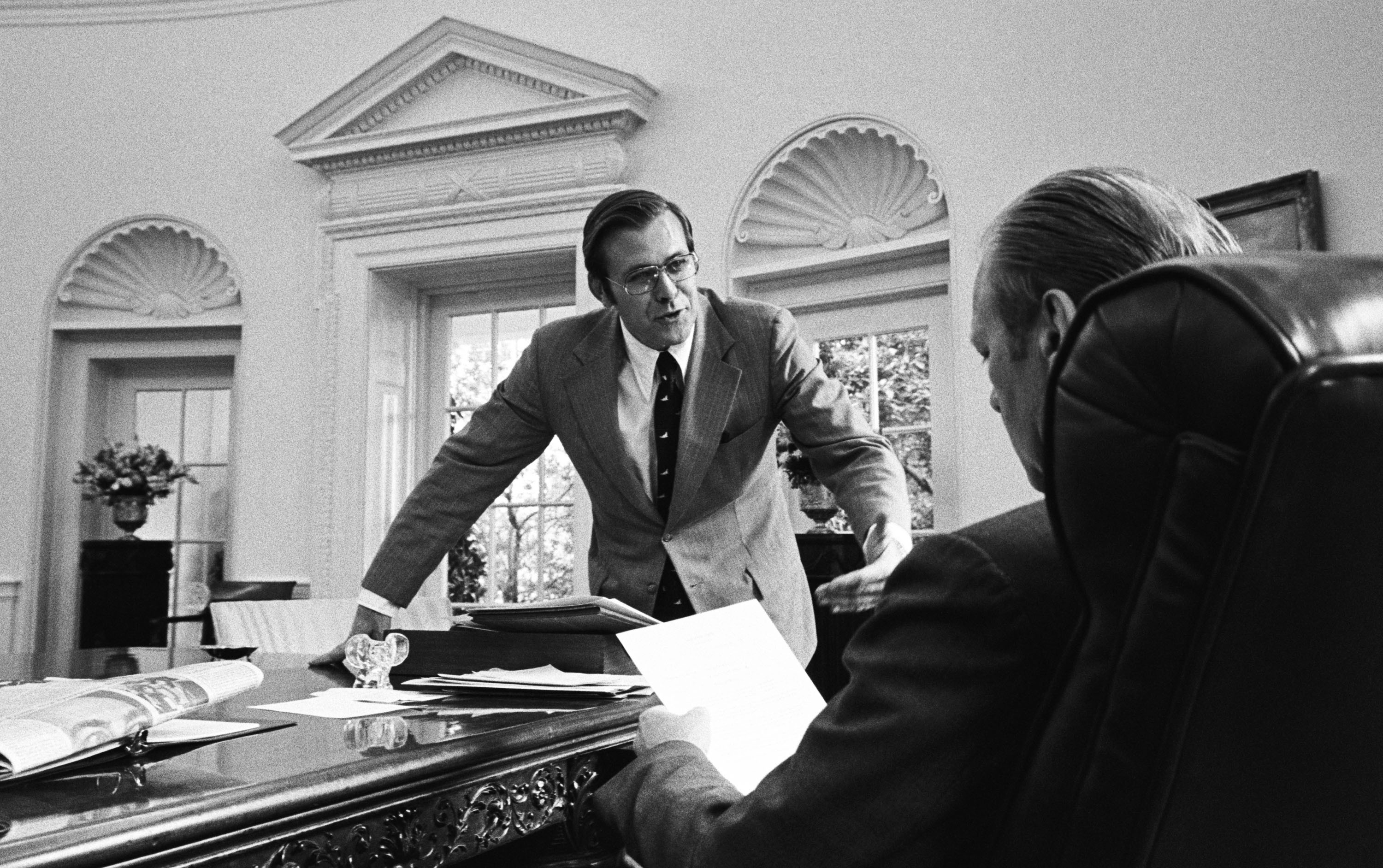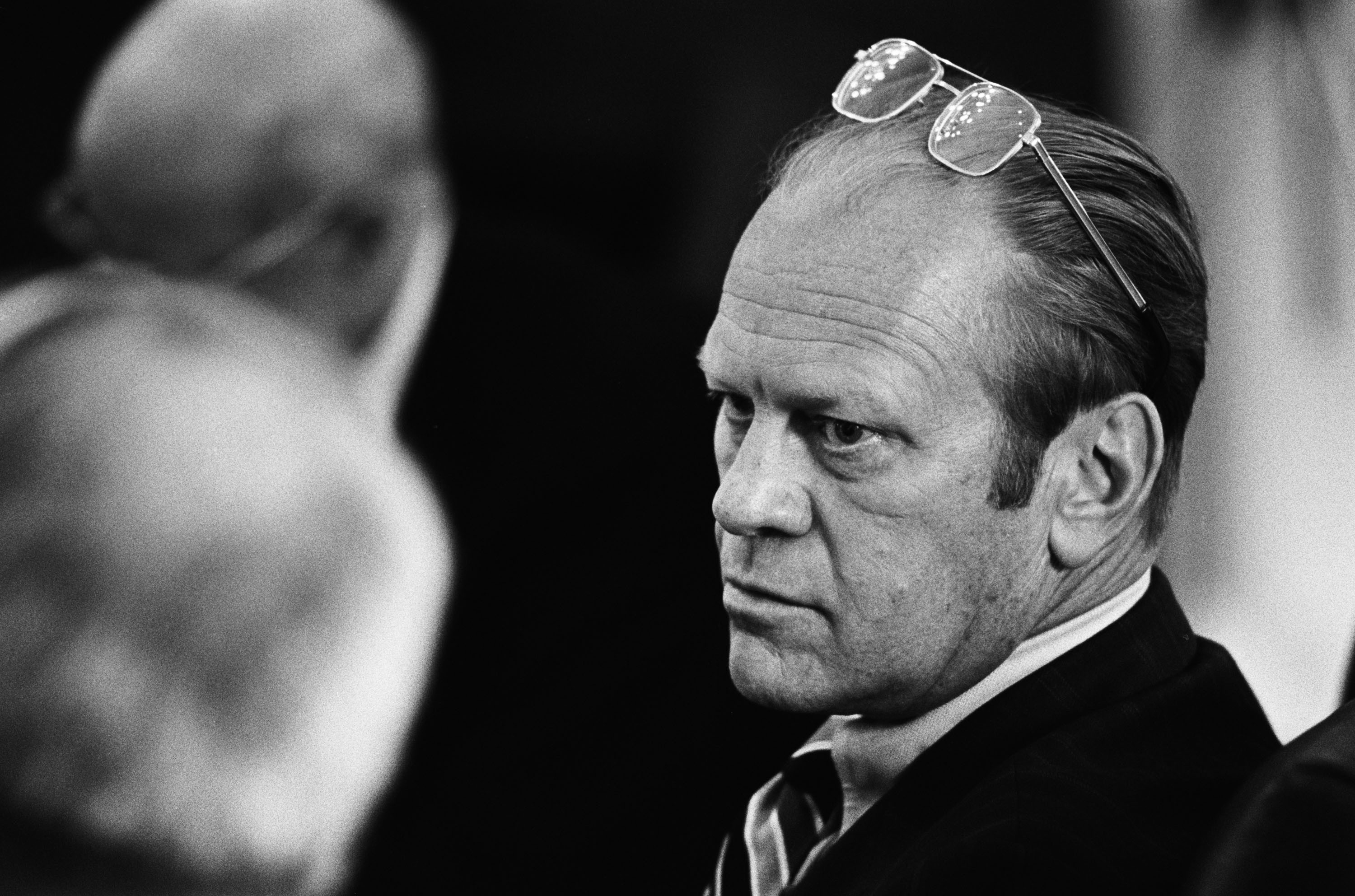A good leader is decisive. When President Ford died in 2006, The New York Times asked me to write an op-ed about a “favorite” photo that I had taken of President Ford. Instead, I offered them this picture, not necessarily a favorite, but one that accurately captured him in a moment of crisis.
My edited version here: President Ford’s military background came solidly into play during this drama. The American-crewed cargo ship Mayaguez had been captured by Khmer Rouge rebels, and the president personally directed the effort to try and get the crew safely released. After diplomacy failed, the president waved off recommendations that involved a B-52 strike on Phnom Penh. He instead ordered a strong, but limited, military action that ultimately secured their freedom. Tension filled the Cabinet Room, but the president’s hand was firmly on the wheel. To me this incident was the fulcrum of his presidency, the point where he came of age as commander-in-chief. In some of the meetings, the president’s advisers talked about how certain decisions might “play.” They wanted to make sure the world knew that America could still use overwhelming force in achieving its ends. But the president didn’t want to hear that. He had no bloodlust. He knew Vietnam was a debacle, as it had been his painful duty to oversee the end of that horrible chapter of our history. Thus he refused to make innocent Cambodians pay for America’s mistakes in Vietnam. This moment illustrated Gerald Ford making the presidency his own. In a word, “resolute,” comes to mind. The man I came to know, admire and love had a quiet and powerful sense of self, and he easily passed that confidence on to all around him. He never surreptitiously nudged a ball to improve his lie in life, a central theme to his character. No single picture will ever sum up the life of President Ford, but this one casts a momentary glimpse into the soul of a man who is greatly missed.


A good leader is a coach. The men and women around President Ford were an essential part of who he was. He picked those whom he trusted and who were the best in the business, and he listened to them. Two of them, Don Rumsfeld and Dick Cheney went on to even greater heights.
Rumsfeld had earned Ford’s trust and respect when as a congressman and a “Young Turk,” he engineered Ford’s rise to House Minority Leader, overthrowing the old-school Charles Halleck. President Ford picked Rumsfeld to be his White House Chief of Staff replacing Al Haig, and Cheney, a protégé of Rumsfeld, followed him into that position. Cheney was inspired by President Ford to “get in the arena” and run for office in his own right. He did so, and two years after leaving the White House as chief of staff, he was sworn in as a congressman from Wyoming. (Ironically, Cheney would most likely have become the first Republican Speaker of the House in 40 years had he not become President George H.W. Bush’s Secretary of Defense. The speakership was the job President Ford had wanted more than the presidency. That honor went to Newt Gingrich in 1995, a Georgia congressman who had been behind Cheney in the House leadership chain.) Cheney, of course, went on to become Vice President of the United States under President George W. Bush, and Rumsfeld became Secretary of Defense, first in the Ford Administration, and then under President George W. Bush.
There are many other key traits that President Ford displayed as a good leader: Honesty. Optimism. Empathy. Authority. Inspiration. Focus. Intelligence. But I will end with one of the most important: Accountability.


A good leader, particularly the President of the United States must be accountable to the American people. After President Ford pardoned former President Richard Nixon he voluntarily appeared before the House Judiciary Committee (controlled by Democrats) to explain why he did it. He was the first sitting president since Abraham Lincoln to undergo that kind of questioning before a Congressional panel, and the last. For two hours he took questions, answering them all. It was an impressive display of our democracy in action. He did it because he was a man of the House and had served in Congress for 25 years before becoming vice president then president. But mainly he did it because he was an American through and through, believed in our country, its constitution and particularly its people. The words and actions of Gerald R. Ford throughout his presidency ring loud and true and should forever be an example to those in power.

David Hume Kennerly has been a photographer on the front lines of history for more than fifty years. At 25 he was one of the youngest winners of the Pulitzer Prize in Journalism for Feature Photography, an award that included images of the Vietnam War. Two years later Kennerly was appointed President Gerald R. Ford's personal White House photographer. American Photo Magazine named him “One of the 100 Most Important People in Photography.” He is currently a contributor to CNN.
Kennerly is the author of seven books. The most recent, David Hume Kennerly On the iPhone, was released in the fall of 2014. Previous books include Shooter, Photo Op, Seinoff: The Final Days of Seinfeld, Photo du Jour, and Extraordinary Circumstances: The Presidency of Gerald R. Ford. He also produced, “Barack Obama: The Official Inaugural Book,” and was one of its principal photographers.
David Hume Kennerly was a featured speaker at the Rumsfeld Foundation’s 2018 Graduate Fellowship Spring Retreat. He also provided the entire collection of photographs used throughout Donald Rumsfeld's latest book, "When The Center Held." Rumsfeld’s profits from the book are donated to the Foundation in support of its Graduate Fellowship Program.


